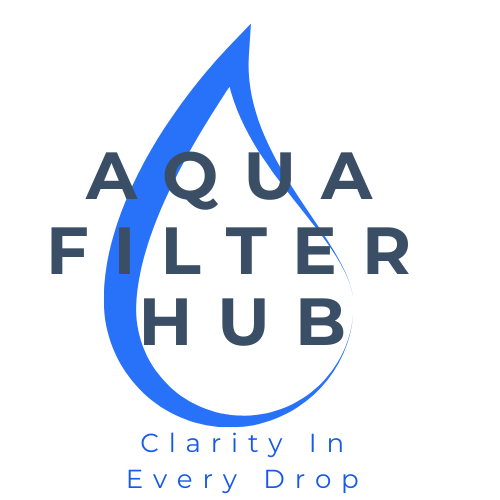Introduction
Tired of chalky dishes, itchy skin, or limescale clogging your pipes? Hard water doesn’t just annoy — it can destroy your appliances, irritate your skin, and shorten the life of your plumbing.
In this guide, I’ll walk you through the best whole house water filters for hard water in 2025 — including salt-free options, filter-softener combos, and real-world tips to help you choose the right system.
Want to compare other filtration systems? Check out our Whole House Water Filters guide for a full breakdown of options.
🔗 Get Your Free Hard Water Checklist:
Key Takeaways
- Hard water is laden with minerals like calcium and magnesium that can reduce appliance efficiency and cause limescale build up.
- The right whole house water filter can tackle these issues while boosting your home’s water quality.
- We compare top systems such as iSpring Three‑Stage, Aquasana, Waterdrop G3, and AO Smith to help you choose the best option.
Struggling with limescale, dull laundry, or bitter-tasting water? You’re not alone. Hard water affects over 60% of households across the US and UK — and choosing the right whole house filter is critical to solving it.
📥 Download our free “Hard Water Filter Checklist” to avoid common mistakes
Top Picks
Top 4 Whole House Systems for Hard Water (2025)
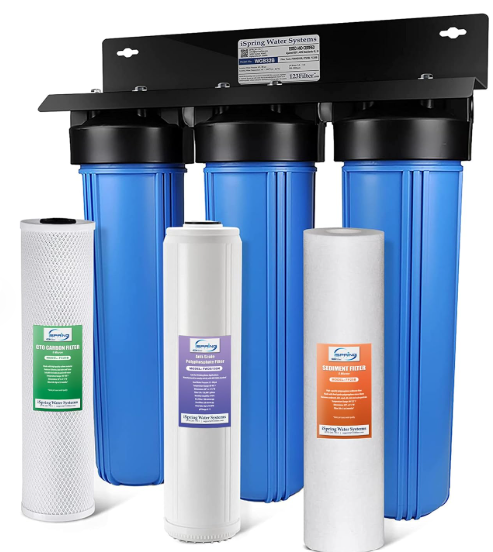
iSpring Three Stage
A multi-stage whole house system designed to tackle hard water minerals while maintaining strong flow rate.
Why It Works:
Removes calcium, magnesium, and sediment with a 3-filter setup optimized for hard water conditions.
Pros:
- Reduces scale buildup
- Maintains water pressure
- High-capacity filters
Cons:
- Some installs require plumber
- No softening function
Best For:
Homes with moderately hard water and scale issues.
View Price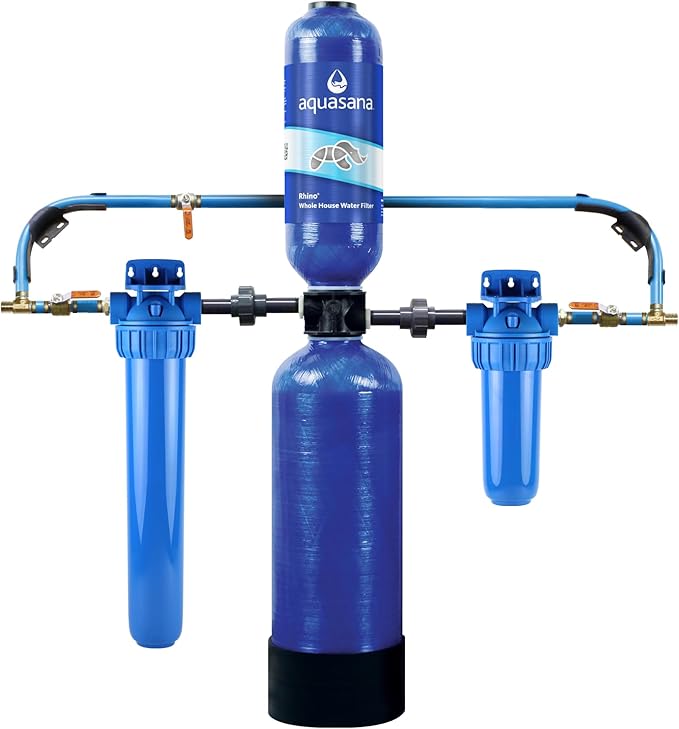
Aquasana Rhino
A long-lasting, high-performance system that tackles hard water effects and improves overall water quality.
Why It Works:
Includes carbon + KDF + salt-free softening media for full-spectrum protection.
Pros:
- Long filter lifespan
- High build quality
- Reduces chlorine, scale, and contaminants
Cons:
- Higher cost
- Professional installation recommended
Best For:
Large homes and users who want low-maintenance, premium protection.
View Price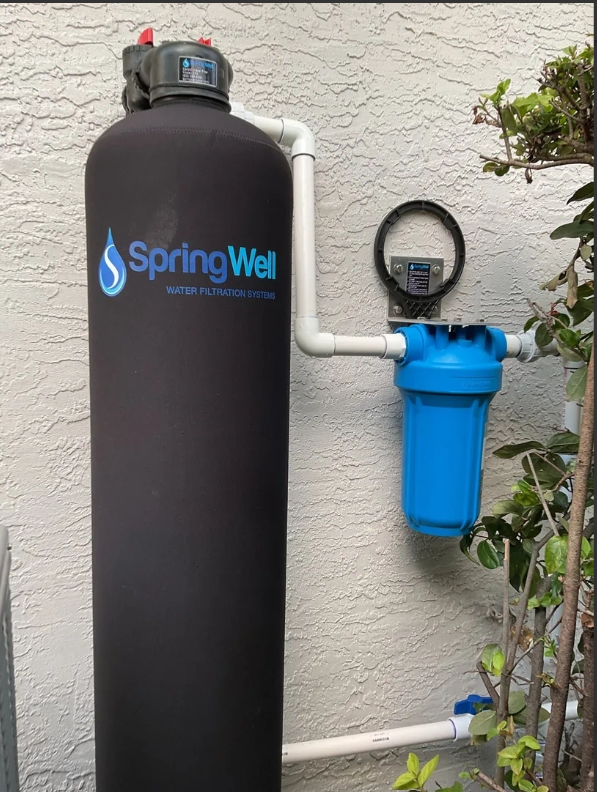
SpringWell CF1 + Optional Salt-Free Softener
A premium whole house water filter that removes contaminants like chlorine and PFAS — with the option to add SpringWell’s salt-free softener for full hard water protection.
Why It Works:
Uses catalytic carbon + KDF filtration for water quality, and can be upgraded with a salt-free conditioner to reduce scale without salt or electricity.
Pros:
- Removes chlorine, VOCs, PFOS/PFOA
- Supports large homes with high flow rates
- Lifetime warranty on tank & valves
Cons:
- Scale protection requires optional softener add-on
- DIY install may need plumbing tools
Best For:
Homeowners who want a future-proof setup that improves water quality and offers optional protection against hard water scale — without the need for salt or brine tanks.
View Price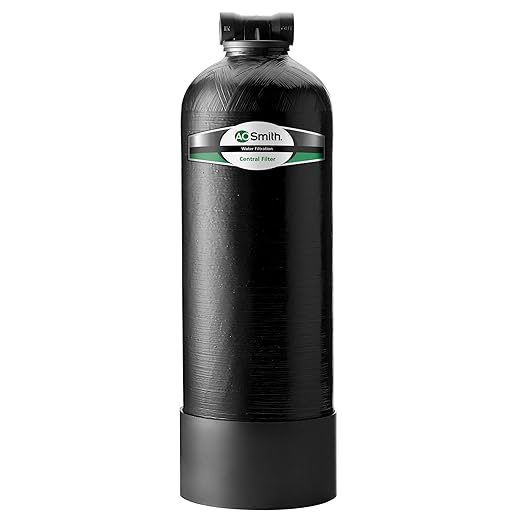
AO Smith Whole House Filter
An affordable filter that helps reduce scale and improve water clarity at a budget price.
Why It Works:
Simple sediment and carbon filtration protects plumbing and fixtures from hardness damage.
Pros:
- Affordable
- Easy to install
- Compact design
Cons:
- Limited advanced filtration
- Shorter lifespan than others
Best For:
Small households or renters looking for simple filtration.
View PriceUnderstanding Hard Water and Its Impact
Imagine turning on your tap and noticing that the water, burdened with minerals, is causing scale to build up in your pipes and reducing water flow. Hard water is rich in minerals like calcium and magnesium. These can wreak havoc on your appliances, reduce water flow, and even affect your skin and hair.
Hard water may lead you to ask:
- What exactly is hard water and how does it impact my home?
- Does a whole house water filter help with hard water?
By addressing these questions, you’re already a step ahead. Hard water can shorten the lifespan of your water filter, leave white spots on dishes, and increase detergent usage. Fortunately, whole house water filters are designed to solve these issues by removing—or at least neutralizing—the minerals that cause such problems.
Before/After Case Studies
Case Study 1: Addressing High Total Dissolved Solids (TDS) in Well Water
Source: RainDance Water Systems
Background: A homeowner with a well water source in a rural area faced challenges due to high TDS, resulting in brackish water that affected daily activities.
Solution: The installation of the RainDance-6000SPEC Custom Whole House Reverse Osmosis (RO) Package was implemented to treat the high TDS levels.
Outcome: Post-installation, the homeowner experienced consistently clean and palatable water, significantly enhancing the quality of daily tasks and overall water consumption.
Visual aids: Before-and-after water quality test results and images of the filtration system can be included to illustrate the improvements.
Case Study 2: Transitioning from Single-Stage to Multi-Stage Filtration
Source: Thunderbird Disco
Background: Residents in a suburban home encountered issues with sediment and heavy metals in their water, leading to concerns about health and appliance longevity.
Solution: They upgraded from a single-stage filtration system to a custom five-stage whole house water filter, incorporating a spin-down sediment filter and a three-stage heavy metals filtration system.
Outcome: The enhanced filtration effectively addressed sediment and heavy metal concerns, resulting in improved water clarity and appliance performance.
Visual aids: Charts comparing water quality parameters before and after installation, along with photographs of the filtration setup, can be provided.
Case Study 3: Implementing a Comprehensive Filtration and Softening System
Source: Traditional Cooking School
Background: A family relocating from Indiana to Idaho sought to improve their new home’s municipal water, aiming to remove contaminants like chlorine, fluoride, and pharmaceuticals while preserving beneficial minerals.
Solution: They installed a three-part system: a whole house water filter, a salt-free water conditioner, and a 14-stage drinking water purification system at the kitchen sink.
Outcome: The system successfully reduced unwanted contaminants, enhanced water taste, and provided peace of mind regarding water quality.
Case Study 4: Enhancing Water Quality in a Home with Well Water
Source: DIY Chatroom Forum
Background: A homeowner with well water experienced issues with sulfur smell and potential contaminants, prompting the need for a comprehensive filtration solution.
Solution: They installed a multi-stage filtration system, including a mechanical filter, UV light treatment, and a carbon filter, to address odor and purify the water.
Outcome: The installation led to the elimination of unpleasant odors and improved water clarity, contributing to a more comfortable living environment.
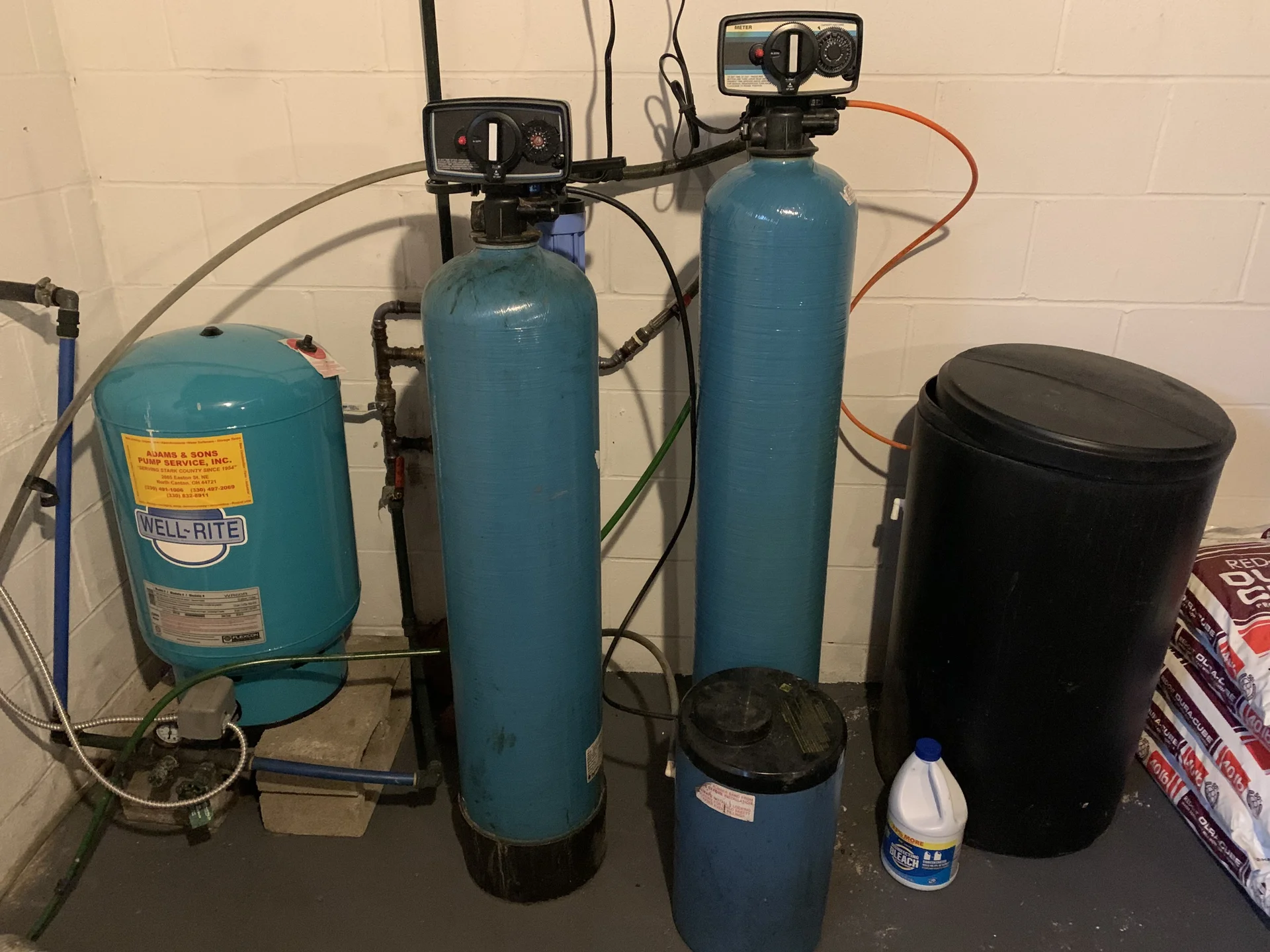
Technical Insights: Flow Rate Calculations
When sizing your whole house water filter, knowing your home’s flow rate is key. Flow rate calculations help you determine the optimal system capacity based on your home’s size, number of residents, and typical water usage. For instance, if you’re running multiple taps, showers, and appliances simultaneously, you might need a system that sustains around 15 gallons per minute (GPM) or more.
To help you visualize this, here’s a quick reference table:
Home Size | Number of Residents | Recommended Flow Rate (GPM) |
|---|---|---|
Small (1-2 bedrooms) | 1-2 | 10-12 |
Medium (3 bedrooms) | 3-4 | 12-15 |
Large (4+ bedrooms) | 5+ | 15-20 |
Flow Rate Calculator
Use this tool to estimate the ideal flow rate (in GPM) for your home’s water filter system — and get a personalized product recommendation.
Enhanced Science Explanation: Measuring Water Hardness
Understanding the science behind water hardness can empower you to choose the right filtration system. Water hardness is typically measured in parts per million (ppm) of calcium carbonate (CaCO₃). Here’s a quick breakdown of the ranges:
Hardness Level | PPM (mg/L as CaCO₃) | Classification |
|---|---|---|
0-60 | 0-60 | Soft (Low scale risk) |
61-120 | 61-120 | Moderately Hard |
121-180 | 121-180 | Hard (Noticeable scale buildup) |
181+ | 181 and above | Very Hard (High scale risk) |
Hard water gets its character from dissolved minerals—mainly calcium and magnesium. Knowing your water’s ppm not only helps you understand potential issues but also guides you in selecting a system that’s powerful enough to counteract scale buildup.
Comprehensive Regional Considerations
Water hardness isn’t the same everywhere. In the UK, for example, South Eastern England typically experiences very hard water due to its chalky geology. In contrast, areas in the northwest might enjoy softer water. Similarly, in the US, regions like the Southwest often have higher hardness levels, while parts of the Northeast experience moderate hardness.
For tailored recommendations:
- South-eastern England Homeowners: Consider systems that use robust ion exchange technology to effectively reduce extreme hardness.
- US Homeowners: If you’re in a region with a mix of contaminants, a combination system (water softener plus reverse osmosis) might be best to tackle both hardness and additional impurities.
By testing your water (using home kits or professional services), you can better understand your local water profile and choose a system that truly fits your needs.
How Do Whole House Water Filters Work for Hard Water?
Whole house water filters for hard water don’t just strain out sediments; they tackle the mineral build-up head-on. Here’s a simple breakdown:
- Ion Exchange Filtration: This process removes calcium and magnesium ions, replacing them with sodium. It’s particularly effective for heavy mineral loads.
- Salt-Free Water Conditioning: Instead of removing minerals, these systems alter their chemical structure, preventing them from forming hard scale.
- Multi-Stage Filtration: Combining technologies like activated carbon, ion exchange, and reverse osmosis ensures comprehensive treatment, addressing not only hardness but also other contaminants.
Not sure which whole house water filter is right for you?
Use our interactive Filter Finder Tool to get a personalized recommendation based on your water hardness, number of bathrooms, and budget. In just a few quick steps, you’ll discover the ideal system for your home — no guesswork needed.
Try it here 👈
Don’t Just Treat Hard Water — Watch for These New Contaminants Too
Emerging Contaminants: A New Challenge in Water Quality
While traditional issues like hard water are well understood and treated by many whole house systems, new contaminants are increasingly drawing attention. Two of the most critical emerging contaminants are microplastics and per- and polyfluoroalkyl substances (PFAS), often dubbed “forever chemicals.” These substances do not break down naturally and have become ubiquitous in our environment, from urban runoff to remote areas.
What Are They?
- Microplastics: Tiny fragments or fibers shed from everyday plastics (such as from synthetic clothing or degraded plastic waste) that can travel long distances in air and water. Studies now show that microplastics can be found even in rainwater, posing potential risks if they accumulate through consumption.
- PFAS: A large group of manufactured chemicals designed to repel water, oil, and stains. Commonly used in nonstick cookware, waterproof fabrics, and firefighting foams, these substances are highly persistent in the environment and can accumulate in our bodies over time.
Potential Health and Environmental Impacts
Emerging research continues to suggest that even at low concentrations, PFAS may be linked to health issues such as hormone disruption, increased cholesterol levels, and adverse effects on the immune system. Although definitive long-term effects of microplastics ingestion remain under investigation, their ability to serve as carriers for other toxic chemicals further raises concerns. For both microplastics and PFAS, the term “forever chemicals” is not used lightly—they resist degradation and can ultimately infiltrate our groundwater and drinking water supplies.
Why This Matters for Your Home
The water that flows into your home might not only contain traditional contaminants (like sediment and chlorine) but also these emerging pollutants. While many modern whole house filters are effective against a range of conventional contaminants, not every system is equally effective at trapping or neutralizing microplastics and PFAS. It may be worth considering advanced treatment options or certified filtration devices that specifically address these concerns.
Future-Proofing Your Water Filtration
As awareness of these emerging contaminants grows, manufacturers are gradually developing systems that target them. In the future, you may want to look for filters that boast certifications against PFAS or include innovative media for microplastic removal. Staying informed and periodically testing your water quality can ensure that your filtration setup meets not just today’s standards but is adaptable to tomorrow’s challenges.
Click here for a detailed guide on removing bacteria from your water
Top Whole House Water Filters for Hard Water in 2025
After careful research and comparisons, here are the top four systems that stand out for solving hard water challenges:
Product Comparison Table
Product | Key Features | Ideal For | Installation | Price Range |
|---|---|---|---|---|
iSpring Three‑Stage | Multi‑stage filtration that targets hard water minerals; reduces scale buildup; maintains good water pressure | Best for hard water | May require professional installation | Mid‑range |
Aquasana | Advanced filtration technology; long‑lasting performance; premium build quality | Premium users | Professional recommended | High‑end |
SpringWell CF1 | High-flow filtration system; reduces chlorine and hardness (with softener add-on) | Best whole house protection | Pro install highly recommended | High-end |
AO Smith | Reliable filtration at an affordable price; ideal for budget‑conscious homeowners addressing hard water issues | Best budget option | Simple installation | Budget‑friendly |
In-Depth Product Reviews:
click below to expand:
iSpring WGB32B
iSpring WGB32B 3-Stage Whole House Filter System
Overview:
The iSpring WGB32B stands out for homes facing moderate to high levels of hard water minerals like calcium and magnesium. This system doesn’t soften water chemically but effectively filters scale-causing particles through a layered three-stage system — sediment, carbon block, and a specialty filter optimized for hardness issues.
💡 Installation Experience:
DIY-friendly for those comfortable with basic plumbing. The unit comes with clear instructions and labeled ports. However, due to its size, wall-mounting requires proper bracket support. Many users on forums recommend adding a bypass valve setup for easier maintenance.
“Installed this in 2 hours with PEX fittings and SharkBites. Added pressure gauges to monitor filter life.” – Reddit user /r/Plumbing
🧰 Maintenance Insight:
Filters last 6–12 months depending on your water’s hardness and sediment levels. The sediment filter often clogs faster if your home has older plumbing. iSpring includes a filter wrench, but consider replacing O-rings annually to prevent leaks.
🛠 Pro tip: Add pressure gauges before and after the filters. A 10+ PSI drop signals it’s time for a change.
📊 Performance in Real Homes:
While it won’t soften water like salt-based systems, most users report a noticeable reduction in scale buildup on appliances and fixtures after 2–4 weeks. Showerheads and faucets see improved flow once sediment is filtered out.
“Our dishwasher no longer has white film after 3 weeks. It doesn’t soften, but it does filter out the worst minerals.” – Verified user review
⚖️ iSpring vs. Salt-Based Softeners:
This system is ideal for homeowners who want to avoid salt systems due to health or environmental concerns. However, it won’t match the feel of soft water (like silkier showers). Pairing it with a salt-free softener downstream may improve results for very hard water zones.
❌ When Not to Buy:
- Water hardness > 15 GPG (grains per gallon) — consider a dedicated softener.
- If you want full chlorine or fluoride removal, consider a system with catalytic carbon or reverse osmosis.
👍 Best For:
Budget-conscious homeowners in moderate-hard water areas (5–12 GPG) who want better water quality without switching to salt-based systems. Also great as a pre-filter for whole-house RO setups.
Aquasana Rhino
Aquasana Rhino EQ-1000-AST Whole House Filter + Salt-Free Softener
Overview:
The Aquasana Rhino EQ-1000-AST combines a comprehensive whole house water filtration system with a salt-free conditioner designed to reduce scale buildup from hard water. Unlike traditional softeners, it uses Scale Control Media (SCM) rather than ion exchange, making it ideal for those who want conditioning without added sodium or wastewater. The system targets sediment, chlorine, VOCs, and scale-forming minerals — making it a strong all-rounder for hard water homes.
💡 Installation Experience:
Installation is moderately complex due to the system’s multi-component setup: sediment pre-filter, main filtration tank, salt-free conditioner, and optional UV add-on. It requires space and a wall-mount or floor-stand setup. Most users recommend professional installation unless you’re confident with pipe cutting and bypass loop configuration.
“Had my plumber install this with a bypass and shutoff valves. Took 3 hours but looks super clean. Definitely not plug-and-play.” – Home Depot review
🧰 Maintenance Insight:
The system is low-maintenance by design. The pre-filter should be changed every 3 months, while the main tank and conditioner are rated for up to 10 years or 1,000,000 gallons. No salt refills or electricity needed, which keeps ongoing costs low. The main challenge is remembering to change the pre-filter regularly, especially in homes with high sediment.
🛠 Pro tip: Mount a date label on the sediment filter housing. It’s easy to forget, and clogs here can reduce whole system flow rate.
📊 Performance in Real Homes:
Users report improved taste, smell, and feel of water within days. While it doesn’t give the “slick” soft water feel, most note a clear reduction in scaling on fixtures, dishes, and shower glass. It also preserves healthy minerals like calcium and magnesium — a plus for those concerned about over-filtration.
“Our water no longer smells like a pool, and our coffee tastes cleaner. We haven’t cleaned our kettle in months, and there’s hardly any buildup.” – Verified Amazon reviewer
⚖️ Aquasana vs. Traditional Softeners:
The Rhino + SCM conditioner system is not a true softener. It alters hardness minerals to reduce scale adhesion rather than removing them. This means no slippery water feel and no sodium added — great for people on salt-restricted diets or those on septic systems. But it may not be sufficient for extremely hard water (>15 GPG) without an additional softener downstream.
❌ When Not to Buy:
- Your water hardness is extreme (>20 GPG). Consider a salt-based softener.
- You need iron or fluoride removal — this system doesn’t handle those.
- You expect zero white spotting on glassware — SCM reduces but doesn’t eliminate this.
👍 Best For:
Health-conscious homeowners in moderate to hard water areas (6–15 GPG) who want scale protection without dealing with salt, brine tanks, or electricity. Ideal for those seeking low-maintenance, eco-friendly conditioning, and all-round home filtration in one package.
SpringWell FutureSoft
SpringWell FutureSoft — The Best Salt-Free Softener for Scale Prevention
If you want protection from hard water — without the salt, waste, or maintenance — SpringWell’s FutureSoft is one of the best options available in 2025.
It’s not a traditional water softener. Instead of using salt to remove calcium and magnesium, it uses Template Assisted Crystallization (TAC) — a proven technology that prevents limescale from sticking to your pipes, fixtures, and appliances.
And the best part? There’s zero salt, zero electricity, and zero wasted water.
What Is the SpringWell FutureSoft?
The SpringWell FutureSoft is a salt-free water conditioner — not a softener in the classic sense. That means it doesn’t remove minerals from your water, but it neutralizes their ability to form hard scale.
This is ideal for anyone on a salt-restricted diet, those with septic systems, or homeowners who simply want a greener, lower-maintenance solution.
You can buy the FutureSoft as a standalone system, or as a combo unit with the SpringWell CF1 filter, which handles chlorine, PFAS, and VOCs — giving you complete protection from both chemical contaminants and hard water scale.
How Does the Technology Work?
FutureSoft uses a proprietary TAC media that crystallizes hardness-causing minerals on contact. Once crystallized, these minerals remain suspended in the water but can’t bind to surfaces — preventing buildup in plumbing, water heaters, and fixtures.
Unlike ion exchange systems (which need salt refills and backwashing), TAC systems like FutureSoft:
- Don’t strip your water of minerals
- Don’t waste gallons of water during regeneration
- Don’t require electricity to function
It’s a true set-it-and-forget-it solution, with the media lasting up to 6 years before needing replacement.
What You’ll Notice in Daily Use
Because FutureSoft doesn’t “soften” water in the traditional sense, you won’t get that slippery soap feel that salt-based softeners cause.
Instead, you’ll notice:
- Fewer white spots on dishes and glass
- Longer lifespan for kettles, heaters, washing machines
- No scaling around taps, showerheads, or faucets
- Reduced maintenance needs on appliances
And because it doesn’t require salt or drain lines, it’s especially popular for eco-conscious households and regions with brine discharge bans.
Quick Facts – SpringWell FutureSoft
| Feature | Details |
|---|---|
| Type | Salt-Free Conditioner (TAC-based) |
| Best For | Homes with hard water and no need for salt removal |
| Grain Capacity | N/A (no resin beads or grain measurement used) |
| Flow Rate | 12–20 GPM depending on model |
| Installation | DIY-friendly; includes bypass valve |
| Maintenance | None — no salt, no electricity, no backwashing |
| Warranty | Lifetime on tank and valves |
| Certifications | Third-party tested for performance |
Pros and Cons
What We Love
- ✅ No salt, no electricity, no waste water
- ✅ Effectively prevents scale buildup
- ✅ Lifetime warranty and American-made build
- ✅ Combines well with SpringWell CF1 for full home protection
- ✅ Quiet, passive system — no moving parts or noise
What to Consider
- ⚠️ Doesn’t remove calcium/magnesium — just neutralizes
- ⚠️ May not soften water “feel” like traditional systems
- ⚠️ Upfront cost higher than cheap softeners (but no ongoing salt or maintenance costs)
Verdict: Who Should Get the FutureSoft?
The SpringWell FutureSoft is perfect for homeowners who want to protect their plumbing and appliances from scale, but don’t want the hassle or waste of a traditional softener.
It’s a future-proof choice that pairs beautifully with whole house filters — and especially ideal for households in brine-restricted regions, or anyone tired of lugging around salt bags.
If you want cleaner pipes, longer appliance life, and water that’s gentle on everything but scale, FutureSoft is one of the best salt-free systems in the game.
AO Smith
AO Smith Whole House Filter + Salt-Based Softener Combo
Best Budget-Friendly Combo Available In-Store
Rating: 4.4 / 5 ⭐
If you’re looking for a practical and affordable way to reduce chlorine and soften hard water at the same time — without navigating custom orders or complicated installs — this AO Smith combo might be the sweet spot. It’s sold at major retailers like Lowe’s, which makes it highly accessible.
Key Features
- Granular Activated Carbon Filter: Helps reduce chlorine taste, sediment, and odor from all taps.
- 35,000 Grain Salt-Based Softener: Uses traditional ion exchange to remove calcium and magnesium — ideal for true softening.
- Pre-Plumbed Bypass Valve: Makes installation and servicing easier.
- DIY-Friendly: Many homeowners report successful installs without pro help.
- Optional Add-ons: UV purifier and sediment pre-filters available separately.
What We Like
- Affordable price point for a dual system (under £1,000 / $1,000 range depending on region).
- Genuine softening effect — this uses salt and actually lowers hardness (unlike salt-free conditioners).
- Widely available in stores, so you can see the unit before you buy.
- Good support from AO Smith, a reputable water tech manufacturer.
What Could Be Better
- Carbon filter is basic — not ideal for removing VOCs, PFAS, or heavy metals.
- Higher ongoing cost due to salt refills and more frequent carbon media changes.
- No smart monitoring or performance tracking like some premium models offer.
- Design is more functional than sleek — not meant to impress visually.
Who It’s Best For
Homeowners who want a straightforward, in-stock, and cost-effective combo that handles hard water and basic filtration. Ideal for families with moderate water concerns who aren’t ready to invest in a $2,000+ system.
Verdict
While it doesn’t match the filtration depth of a SpringWell or Aquasana, this AO Smith combo gets the job done — softening water and improving taste without breaking the bank. It’s a solid choice for first-time buyers or anyone who prefers big-brand reliability with local availability.
Why These Filters Made the Cut
Each of these systems offers a unique advantage depending on your budget, home size, and water quality needs:
AO Smith stands out as a budget-friendly option that still tackles chlorine and sediment effectively — a solid choice for smaller homes or city water users.
iSpring WGB32B gives you reliable, three-stage protection without overcomplicating things — perfect for homeowners who want solid performance at a reasonable price.
Aquasana Rhino delivers premium contaminant removal and long filter life, ideal for families ready to invest in long-term water quality.
SpringWell CF1 is the top pick for those who want future-proof flexibility, with options to upgrade to salt-free softening or UV filtration as needed.
Note: For more detailed insights and user reviews, consider visiting reputable sources like Consumer Reports and EPA for additional industry data.
Frequently Asked Questions
To help you make an informed decision, here are some FAQs woven naturally into the discussion:
- What exactly is hard water?
Hard water contains high concentrations of minerals like calcium and magnesium. These minerals cause limescale build up, which affects your plumbing and appliances. A whole house water filter designed for hard water targets these minerals, preventing scale formation. - How do whole house filters work differently from regular filters?
While standard filters may only remove sediments and some contaminants, whole house systems for hard water focus on reducing or altering minerals that cause hardness. This might include using technologies such as ion exchange or salt‑free conditioning. - Will a whole house water filter affect my water pressure?
All filters cause some pressure drop, but high‑performance models like those in our top picks are engineered to minimize this impact, ensuring you still enjoy strong water flow throughout your home. - How often do filters need replacement?
Replacement schedules vary. Carbon filters, for example, typically need changing every six months, whereas specialized filters in systems like reverse osmosis may last 1‑2 years. Always follow the manufacturer’s recommendations. - Is a whole house water filter effective for well water?
Yes, many systems are designed to tackle well water challenges too, especially if you have additional contaminants beyond hardness.
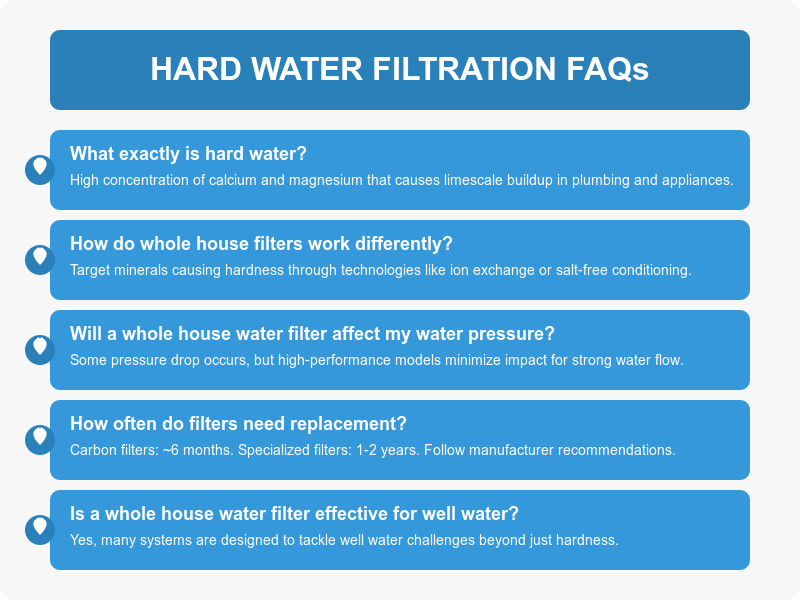
Expert Insights and Real‑World Experiences
As a homeowner, I’ve personally seen the benefits of using a whole house water filter system. One friend, after installing a system similar to the iSpring Three‑Stage, noticed a dramatic improvement in water flow and a significant reduction in scale around the sink and shower. Testimonials from platforms like HomeAdvisor and Consumer Reports also echo these positive experiences.
Verified user reviews confirm that investing in a quality system not only improves water quality but also extends the lifespan of appliances. Remember, when it comes to protecting your home, a little upfront research now can lead to long‑term savings and better performance.

Environmental Impact Analysis
Beyond just improving water quality, it’s important to consider the environmental footprint of your filtration system. Different methods have varying impacts:
- Salt-Based Systems:
- Pros: Highly effective at removing hardness minerals.
- Cons: Require regular salt replenishment and can contribute to environmental salt buildup, potentially affecting local water quality.
- Salt-Free Water Conditioners:
- Pros: Alter mineral properties without adding chemicals, resulting in lower salt usage and minimal environmental disruption.
- Cons: May not completely remove hardness, meaning some minerals remain in the water.
- Multi-Stage Filtration (Including Reverse Osmosis):
- Pros: Provide comprehensive treatment by combining methods; reduce heavy metals and other contaminants.
- Cons: Reverse osmosis systems often produce wastewater, which can be a concern if not managed properly.
- Energy and Water Efficiency:
Systems designed with energy efficiency in mind not only lower your utility bills but also reduce overall environmental impact. Look for models that balance water conservation with effective filtration.
In today’s eco-conscious world, choosing a system that minimizes water waste and energy consumption is as important as its filtration performance. This way, you ensure that every drop of water—and every watt of energy—is used as efficiently as possible.
Installation, Maintenance, and Cost Considerations
Before purchasing a system, keep these points in mind:
- Installation Requirements:
Most systems require installation on your main water line. Some models, such as the Waterdrop G3, are designed for easy DIY installation. However, more complex systems might require professional help. - Maintenance:
Regular filter replacement and system cleaning are key. Consider scheduling maintenance as part of your routine to ensure the system’s longevity and optimal performance. - Cost Factors:
Evaluate both initial costs and ongoing expenses like replacement filters. While systems like AO Smith are budget‑friendly, others may demand a higher upfront investment but offer long‑term benefits and lower maintenance costs.
The Future of Whole House Water Filters for Hard Water
The trends in water filtration technology continue to evolve. With growing concerns about water quality and environmental impact, newer systems are integrating eco‑friendly features and advanced filtration methods. As manufacturers focus on sustainability, you’ll find systems that not only improve your water quality but also minimize waste and energy consumption.
Use interactive tools like online flow-rate calculators and step-by-step installation videos to simplify the process. These resources help you choose the right system for your home with confidence, ensuring clarity in every drop.
Want a simplified version?
Grab our free Hard Water Checklist — everything you need to know, no fluff.
Final Thoughts
Choosing the best whole house water filter for hard water isn’t just about addressing a nuisance—it’s about investing in your home’s future, your family’s health, and the longevity of your appliances. To summarize:
- Hard water issues are common and can significantly impact your home.
- A well‑chosen water filter system like the iSpring Three‑Stage or Aquasana offers targeted solutions for hard water challenges.
- Evaluate installation, maintenance, and long‑term costs before deciding.
- Leverage interactive tools and expert insights to make an informed decision.
Now that you’re equipped with detailed product comparisons, FAQs, and expert advice, it’s time to take action. Discover even more insights and detailed guides on whole house water filtration by visiting our Whole House Water Filters page.
Need help choosing? Try our free Whole House Filter Finder quiz — it’s quick, personalized, and based on your real water needs. Click here 👈
This post is brought to you with a commitment to accuracy and clarity. For further authoritative information, check out sources like NSF International and EPA.
Remember: clarity in every drop is not just a tagline—it’s a promise.
Affiliate Disclaimer:
Some of the links in this post may be affiliate links. This means we may earn a small commission if you click through and make a purchase—at no extra cost to you. We only recommend products we genuinely believe provide value. Thank you for supporting Aqua Filter Hub.

